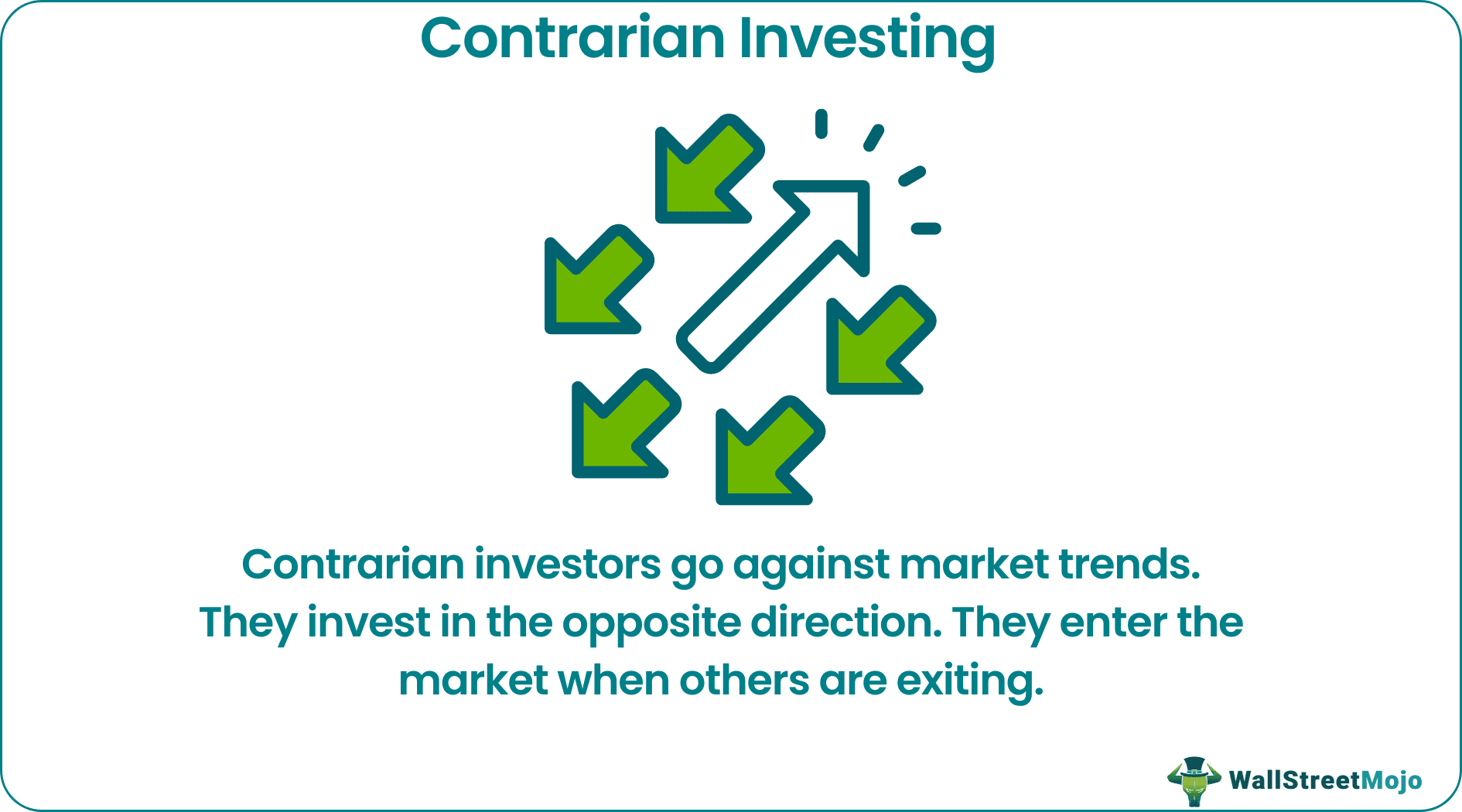Table Of Contents
What is Contrarian Investing?
Contrarian investing is a strategy where individuals invest against the market trend, i.e., in the opposite direction. The decision is backed by thorough research on investor sentiments. It requires patience and an impeccable understanding of the market.
Contrarian investors seek profitable opportunities by going against the tide—they enter the market when others are exiting. This strategy requires a long-term perspective and the ability to find opportunities amidst negative market sentiments.
Key Takeaways
- Contrarian investing is an investment strategy adopted by the investors who make investment decisions out of the box, i.e., against market trends and investors' sentiments.
- Warren Buffet, Jim Rogers, John Templeton, George Soros, Bill Ackman, Peter Lynch, and Marc Faber are some of the most renowned contrarians.
- This investment strategy can also become a nightmare. If investors neglect even a small detail, losses can pile up. The required skills take time to develop—require trial and error.
Contrarian Investing Explained
Contrarian investing is a strategy adopted by visionary investors who invest with a long-term perspective. These investors don't time the market. They study market movements and determine the direction of herd investors—they move in the opposite direction.

However, it is a planned action—the decision to go against herd sentiment is backed by intensive market research. The research is especially focused on a particular company. After all, the investment’s success or failure depends on the company’s performance—business operations, SOP, and management of resources.
In the long run, contrarian investors yield impressive profits—their portfolio outperforms average market returns. Moreover, if the portfolios are diversified using multiple contrarian stocks, risk can be mitigated successfully.
On the opposite spectrum, contrarian investing can become a nightmare for investors. This strategy requires a thorough understanding of the entire stock market. If investors neglect even a small detail, losses will pile up. These skills develop over time—require trial and error.
Sometimes, contrarians panic—in a dilemma they revert their decision and end up incurring significant losses. Also, portfolios don't reflect the profits till the stocks bounce back—while tracking, investors need to be patient with stock performances.
Video Explanation of Contrarian Investing
Contrarian Investing Characteristics
The following features distinguish contrarian investing from other investment strategies:
- Intensive Market Research: Contrarian investors spend time studying market trends—they thoroughly research investor sentiments.
- Independent Decisions: These investors go against the standard practice—they have a different way of perceiving investment opportunities. This is possible because they make independent decisions.
- Long-Term Perspective: Investors should always think long-term. Contrarian investors target stocks that are falling in the present but have the potential to reach record-high peaks in the future.
- Patience: When everyone is withdrawing from a falling stock market, contrarian investors enter. Therefore, they must stay calm and remain invested without doubting their decision.
- Attentiveness: Attention to detail is a must. Traders should closely monitor fluctuations in the market and invest in securities. If a stock deviates from anticipated projections, contrarians must take prompt actions to minimize the loss.
- Every Negative Market Sentiment Has an Opportunity: In contrarian investing, natural calamities, pandemics, and economic downturns are seen as an opportunity. These events have a sudden impact on stock prices. Prices bounce back when the condition is brought under control.
Example
Most contrarians are keeping an eye on Warner Bros. Discovery (WBD) stocks. On April 8, 2022, AT&T Inc. announced a merger between WarnerMedia business and Discovery. In response to the merger, WBD stocks have been plummeting. WBD stocks fell from an initial price of $25 per share to $18.15 per share on April 29, 2022.
Despite the downward trend, contrarians consider it a bargain—an opportunity that could yield earnings per share of $1.61 in 2023. The present decline reflects herd investor sentiments—most investors are withdrawing their investment.
Also, merger expenses need to be accounted for. Added expenses are a challenge for Warner Bros. Discovery, but contrarians believe it will surely bounce back in 2023.
Top Contrarian Investors
Some of the popular contrarians are listed below:
Warren Buffet is a very renowned contrarian. He did not believe in entering a market where everyone was investing heavily. He believed in investing when others were exiting. He reaped 100 times what he invested in Washing Post Company in the 1973-74 bear market.
During the second world war, John Templeton took a risk—he procured shares of companies valued below $1. In addition, he borrowed $10,000 to invest in those companies. Templeton believed these stocks were temporarily undervalued—due to political issues. He was proven right—within five years, his investment became $40,000.
The "Soros Way" of investing was contrarian. George Soros bet on the unexpected (least preferred stocks) and amassed massive gains. Soros once bet on the anticipated fall of the British pound in 1992. Surprisingly, on September 16, 1992, the US dollar and German mark thrashed England's currency—Soros marked a profit of $1.2 billion.
According to Peter Lynch, a falling market has tremendous buying opportunities. He invested $20 million from the Fidelity Magellan Fund in 1977. By 1990, the fund was worth $13 billion.
Frequently Asked Questions (FAQs)
Markets are dictated by two factors, fear and greed. Therefore, for contrarians, the best time to invest is when the investors are afraid. Also, they are alarmed when investors become greedy—they divest.
If market research is thorough, mergers, acquisitions, and market changes can result in tremendous profits for contrarians.
Contrarian strategy is completely opposite to prevailing market sentiments. In contrast, a momentum investment strategy is a basic trading pattern—investors purchase when stock prices rise and sell when the price peaks.
